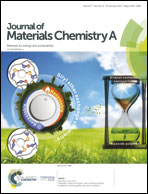One-pot gamma ray-induced green synthesis of a Prussian blue-laden polyvinylpyrrolidone/reduced graphene oxide aerogel for the removal of hazardous pollutants†
Abstract
In this work, a unique one-pot green synthesis technique that utilizes high energy gamma-irradiation technology was successfully designed to fabricate a stable, highly-porous Prussian blue (PB)/polyvinylpyrrolidone (PVP)/reduced graphene oxide (rGO) aerogel (PB@PVP/rGO) with a 3D-network structure, low density, and high mechanical strength. In this synthesis process, PB nanoparticles were generated in situ and then homogenously distributed and entrapped within the PVP/rGO aerogel. The synthesized aerogel exhibited (i) a three-dimensional microporous architecture consisting of an interconnected network structure with an ultra-low density of 0.0273 g cm−3; (ii) remarkable swelling ability in the presence of water at low pH levels; and (iii) strong mechanical stability, leading to excellent deformability without cracks or the loss of structural integrity, due to the double-network structure of the PB@PVP/rGO aerogel and the crosslinking between the stiff GO sheets and the flexible PVP chains. The hydrophilic PB@PVP/rGO aerogel demonstrated the rapid adsorption of Cs+ ions and MB dye due to capillary action; based on the Langmuir model it demonstrated a maximum adsorption capacity of 143.88 and 44.73 mg g−1 for Cs+ and MB, respectively. The PB@PVP/rGO aerogel also exhibited outstanding oil absorption capacity, which we attribute to its highly interconnected porous structure and the presence of oleophilic rGO. The excellent adsorption properties coupling with the unique structural features of this PB@PVP/rGO aerogel make it a promising adsorbent for oil spills and for the removal of environmental pollutants such as Cs+ and MB in water.



 Please wait while we load your content...
Please wait while we load your content...